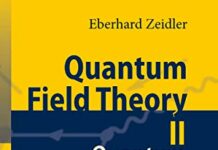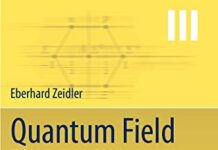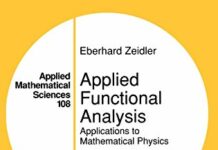
Ebook Info
- Published: 2006
- Number of pages: 1076 pages
- Format: PDF
- File Size: 6.75 MB
- Authors: Eberhard Zeidler
Description
This is the first volume of a modern introduction to quantum field theory which addresses both mathematicians and physicists, at levels ranging from advanced undergraduate students to professional scientists. The book bridges the acknowledged gap between the different languages used by mathematicians and physicists. For students of mathematics the author shows that detailed knowledge of the physical background helps to motivate the mathematical subjects and to discover interesting interrelationships between quite different mathematical topics. For students of physics, fairly advanced mathematics is presented, which goes beyond the usual curriculum in physics.
User’s Reviews
Editorial Reviews: Review From the reviews:”Quantum field theory combines relativity, quantum mechanics, and many-particle physics to provide a theoretical basis for the most fundamental understanding of our universe. … it is a fun book for practicing quantum field theorists to browse, and it may be similarly enjoyed by mathematical colleagues. Its ultimate value may lie in encouraging students to enter this challenging interdisciplinary area of mathematics and physics. Summing Up: Recommended. Upper-division undergraduates through faculty.” (M. C. Ogilvie, CHOICE, Vol. 44 (9), May, 2007)”This is the first volume of a six volume book on quantum field theory. … The main object is to explain mathematics for students or researchers in physics how to use them, and to show students and researchers in mathematics how to use them, and to show students and researchers in mathematics how to use mathematics in physics. Translations of different languages used by mathematicians and physicists for the same mathematical objects are also presented.” (Akira Asada, Zentralblatt MATH, Vol. 1124 (1), 2008)”This book on quantum field theory, consisting of over a thousand pages, is the first volume of a projected six-volume series. It alone has seventeen chapters and an appendix … . The appendix covers notation, units, and dimensional analysis. … Quantum field theory is one of the great intellectual edifices in the history of human thought. … This volume differs from other books on quantum field theory in its greater emphasis on the interaction of physics with mathematics. … an impressive work of scholarship.” (William G. Faris, SIAM Review, Vol. 50 (2), 2008)“Volume I is divided in three parts. Part 1 has an introductory nature. … Part II accompanies the reader through a forest of basic techniques in mathematics. … In Part III, Zeidler presents the essential available information on heuristic magic formulas of quantum field theory. … The presentation of the material is clear. … For a scholar aiming to work in quantum field theory … Zeidler can be a reference text. … Mathematicians can find a list of topics who are still waiting rigorous treatments.” (Paolo Maria Mariano, Meccanica, Vol. 46, 2011) From the Back Cover This is the first volume of a modern introduction to quantum field theory which addresses both mathematicians and physicists ranging from advanced undergraduate students to professional scientists. The book tries to bridge the existing gap between the different languages used by mathematicians and physicists. For students of mathematics it is shown that detailed knowledge of the physical background helps to motivate the mathematical subjects and to discover interesting interrelationships between quite different mathematical topics. For students of physics, fairly advanced mathematics is presented, which is beyond the usual curriculum in physics. It is the author’s goal to present the state of the art of realizing Einstein’s dream of a unified theory for the four fundamental forces in the universe (gravitational, electromagnetic, strong, and weak interaction).From the reviews:”… Quantum field theory is one of the great intellectual edifices in the history of human thought. … This volume differs from other books on quantum field theory in its greater emphasis on the interaction of physics with mathematics. … an impressive work of scholarship.” (William G. Faris, SIAM Review, Vol. 50 (2), 2008) “… it is a fun book for practicing quantum field theorists to browse, and it may be similarly enjoyed by mathematical colleagues. Its ultimate value may lie in encouraging students to enter this challenging interdisciplinary area of mathematics and physics. Summing Up: Recommended. Upper-division undergraduates through faculty.” (M. C. Ogilvie, CHOICE, Vol. 44 (9), May, 2007) About the Author Prof. Dr. Dr. h.c. Eberhard Zeidler works at the Max Planck Institute for Mathematics in the Sciences in Leipzig (Germany). In 1996 he was one of the founding directors of this institute. He is a member of the Academy of Natural Scientists Leopoldina. In 2006 he was awarded the “Alfried Krupp Wissenschaftspreis” of the Alfried Krupp von Bohlen und Halbach-Stiftung. The author wrote the following books.(a) E. Zeidler, Nonlinear Functional Analysis and its Applications, Vols. I-IV,Springer Verlag New York, 1984-1988 (third edition 1998).(b) E. Zeidler, Applied Functional Analysis, Vol. 1: Applications to Mathematical Physics, 2nd edition, 1997, Springer Verlag, New York.(c) E. Zeidler, Applied Functional Analysis, Vol. 2: Main Principles and Their Applications, Springer-Verlag, New York, 1995.(d) E. Zeidler, Oxford Users’ Guide to Mathematics, Oxford University Press, 2004(translated from German). Read more
Reviews from Amazon users which were colected at the time this book was published on the website:
⭐If is not too unfair to say that quantum field theory is a kind of bag of tricks, but considering its monumental experimental success it is apparent that these tricks have worked. From a mathematical standpoint they are very suspect, and the professional mathematician who studies the formalism of quantum field theory will be aghast at its non-rigor, especially in the area of renormalization. That is not to say that no attempts have been made to put quantum field theory on a rigorous mathematical foundation. This has occupied the time of many researchers, but as of yet, such a foundation has not been found. In spite of this, and justifiably so, quantum field theory goes on, and people taking up its study are faced at times with making choices between mathematical rigor and physical relevance. The author of this book, the first of a planned series of 4 volumes, realizes this and has attempted to give the reader a first glance of quantum field theory that emphasizes both the physics and the mathematical relationships that are part of its narrative. In general the author does a fairly good job, even though at times the details of certain subjects are left out, while others are developed to excess.From selective chapters, this reviewer found that the following discussions stand out:A Glance at Topology:This chapter does not contain a whole lot of insights or material that cannot be found in other books. The author it seems wants to whet the reader’s appetite but clearly wants to put off detailed discussion of the mathematics until Volume 3 or 4 of this series. There are a few places in the chapter though that deserves some comment:- The concept of transversality is introduced for curves when discussing intersection theory but the author does not use the tangent space. Instead, he alludes to the `generic’ property of transversality, namely that it can be obtained by sufficiently small perturbations which are `stable”. Stability is a measure-theoretic concept and so the author explains this briefly by Sard’s theorem.- The first Chern class of the tangent bundle of the sphere is stated but not motivated. Readers will have to search intensely for this motivation in the original literature, and will find that it is relatively scant, as is the entire literature on characteristic classes in this regard. There are many books and monographs on the subject, but most, if not all, are purely formal and do not motivate the concepts in a way that they can be truly appreciated. If the author is able to pull this off in the later volumes, it would be a major advance in the education of quantum field theory.- There is an interesting discussion of the Hopf fibration of the 3-dimensional sphere, but emphasizing the physics rather than the mathematics. The author uses the Hopf fibration to characterize the quantum states of a non-relativistic electron, but again defers the proof of the important results to Volume IV. Essential to his discussion is his claim that representing electron quantum states in this fashion is an indication of “nonlinearity.”Many-Particle Systems in Mathematics and Physics- The author cannot resist relating the partition function of statistical physics with number theory and the Riemann zeta function. His discussion is fitting given the current work on proving the Riemann hypothesis using ideas from quantum field theory.- Modular forms are briefly discussed here, which again is fitting because of the work of a few mathematical physicists who are attempting to show connections between the Langlands program in algebraic geometry and number theory and the notion of duality in gauge theories and string theory.- The discussion on the Casimir effect is interesting, mainly because the author explains how physicists view the notion of convergence in a series. Physicists are actually more receptive to using divergent series, with the renormalization program in quantum field theory being the best example of this. Several summation methods for divergent series have been invented and used by physicists. The author gives a very detailed, superb discussion on the analytic number theory behind the Casimir effect.Rigorous Finite-Dimensional Magic Formulas of Quantum Field Theory- The title of this chapter is interesting, given the infinite-dimensional nature of quantum field theory. But apparently the author wants to build the reader’s confidence and intuition using ordinary linear algebra of finite-dimensional Hilbert spaces (with a bit of Dirac calculus and discrete path integrals thrown in).- One of most useful relations for calculations in quantum field theory, especially gauge theory, namely that DetA = Exp(Tr(Ln(A))) is discussed here in the context of Lie groups.- The Dyson series, the bread-and-butter of perturbation calculations in quantum field theory is discussed and viewed as a consequence of the principle of superposition.- The treatment of the functional calculus is rigorous, but this may mislead the newcomer to quantum field theory as being extendable to the full infinite-dimensional quantum field theory.Rigorous Finite-Dimensional Perturbation Theory- This chapter is very interesting in that it views the issues in the renormalization of quantum field theory as a problem in bifurcation theory. In fact the author makes the somewhat radical statement that this is similar to the problems in chaotic classical dynamics where the motions of asteroids for example are complicated because of the resonances that can occur. “The complexity of phenomena in quantum field theory is caused by resonances,” he states. Readers more knowledgeable about quantum field theory, such as this reviewer may find this somewhat novel and will no doubt want to study the chapter in more detail than the others to see just how good this analogy is. In this regard, it must be remembered that this discussion takes place in finite dimensions, and so the analogy to bifurcation on second glance may not be too surprising.
⭐Whenever I read a book on quantum field theory, I have felt that there are something missing. This is not the faults by the authors. Since the QFT is widely used in most fields of physics, it should be limited in writing such a book. It is believed to be impossible for writing a complete book on the QFT in its various aspects.In my institution, I was enforced to give several lectures on solid states physics to whom have no knowledge on quantum physics, of course, they have no knowledge on Hamiltonian physics neither. The undergraduate background of the students are very diversified, from mathematics to engineering. There Ph.D. major will not be Physis, certainly. I spent many years with nightmare for preparing those lecture courses. Working as a computational physicist in an engineering school could not be a recommended choice! For several years, I have tried to step outside the QFT for living.During my struggling to absorb the strange way of thinking by metallurgists, I noticed a way to tackle dislocations in the line with the approach suggested by Stephen Hawking for black holes armed with homotopy. I rushed to my bookshelves and to pick up a book of Dirac on the general theory of relativity as well as the QFT books, e.g., Bjorken & Drell, Fetter & Walecka, and Negele&Orldando. In addition, the book of Zinn-Justine and of P. W. Anderson are always helpful. Those books awoke my interests in the QFT. I also bought a couple of books on the QFT in the curved spacetime. I just read them at a glance and I confirmed my idea. The required methods are there in. Unfortunately, I am not an expert in these fields: Kohn-Sham equation is my best field. In order to show up the results of my idea, I need a very systematically written book on QFT, especially with emphasis in mathematics. Once I confirm those mathematics, computer programming is just a laboring job. At that time, my understanding in QFT is just for drawing an overall picture of QFT with foggy rememberance of its mathematical details with little more rigor. The requirement for little more rigor than current text books is crucial for computational scientists’ programming; otherwise I have to dig articles in the mathematical journals. Teaching QFT to a computer is not an easy job.I found this series during my QFT reviewing process. I was not sure whether this series, as many books written by mathematicians, will disappoint me or not. Indeed in this book, Zeidler quoted the speech of C. N. Yang: “There exist only two kinds of modern mathematics books: one which you cannot read beyond the first page and one which you cannot read beyond the first sentence.” I agree his quote. However, Zeidler made me to breathe a sigh of relief.This seriese is not neither an introductory book nor a physicists book. After I read this series at a glance, my feeling was similar to that when I first read the books of Arfken or Morse&Feshbach. Great! This series is that one I wished before. Now, I am spending very happy times by following this seriese with one-by-one derivations.However, I cannot give five stars. I am still a physicist.Thank you very much Prof. Zeidler!
Keywords
Free Download Quantum Field Theory I: Basics in Mathematics and Physics: A Bridge between Mathematicians and Physicists in PDF format
Quantum Field Theory I: Basics in Mathematics and Physics: A Bridge between Mathematicians and Physicists PDF Free Download
Download Quantum Field Theory I: Basics in Mathematics and Physics: A Bridge between Mathematicians and Physicists 2006 PDF Free
Quantum Field Theory I: Basics in Mathematics and Physics: A Bridge between Mathematicians and Physicists 2006 PDF Free Download
Download Quantum Field Theory I: Basics in Mathematics and Physics: A Bridge between Mathematicians and Physicists PDF
Free Download Ebook Quantum Field Theory I: Basics in Mathematics and Physics: A Bridge between Mathematicians and Physicists


